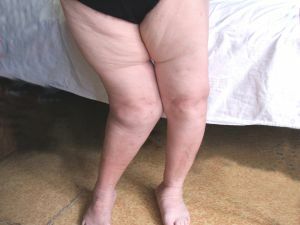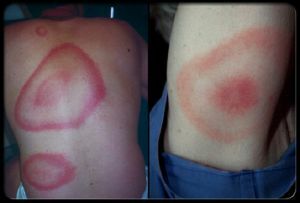 Tick-borne borreliosis( Lyme disease) is a disease that has a wide range of clinical picture and leading to deplorable results of .
Tick-borne borreliosis( Lyme disease) is a disease that has a wide range of clinical picture and leading to deplorable results of .
People are poorly informed on this issue and, as a rule, ignore the first signs of borreliosis, afterwards strongly regretting it.
Specialists also do not agree on the diagnosis of this disease, and its treatment. The article will help to understand the question of what kind of disease it is and why it should be known.
Contents
- Causes of tick borreliosis
- Factors and risk groups
- Classification of the disease
- The course of the disease
- According to the clinical signs
- By the severity of the manifestation
- Epidemiology and etiology
- Signs and symptoms of Lyme disease
- The first symptoms of borreliosis in humans after the tick bite
- Symptoms of acute form
- Firststage
- Stage two - more severe
- Stage three - final
- Chronic form
- Diagnosis
- Treatment of disease
- Typeabout: Lyme borreliosis( Lyme disease)
Causes Lyme disease
Lyme disease is acquired, infectious disease. The causative agent of the disease is an infected borrelia Ixodes tick, and in particular its bite.
The first symptoms of borreliosis are headache and muscle pain, fatigue, redness of the skin( erythema).
Subsequently, the rapid multiplication of microorganisms - Borrelia, damaging tissues of internal organs and body fluids of the patient, there are pains in joints and muscles, affects the nervous system and musculoskeletal, heart and, as a result, loss of ability to work.
The defeat of people with Lyme disease is several times more likely than with tick-borne encephalitis.
A disease in honor of the town of Lyme, in the USA, where the case was first recorded and described. Currently, the disease is observed in most parts of the country.
According to the latest statistics, cases of the disease have occurred in some European countries. Russia was no exception. Cases were recorded in different parts of it.
Risk factors and groups
The risk group for Lyme disease includes: 
- Risk factors are places with lush vegetation, temperate climatic zones( forests, parks, recreation areas).
- The time of year( according to the statistics of registration of the first and last seasonal cases) is March - October. The peak of the activity of infection is the summer months.
- The risk group includes residents of forested areas, leshoz workers, hunters, fishermen, summer residents
- Pets that are on the street( they are able to bring a tick to the premises).
Classification of the disease
In the medical literature, Lyme disease is classified by many parameters.
The disease of
There are species:
According to the clinical signs of
For acute and acute acute course they are identical and described in general:
- erythematous form with lesions of the nervous system, joints and heart;
- is an erythritic form with lesions of the nervous system, joints and heart.
Chronic course:
- continuous with damage to the nervous system, joints, muscles and heart;
- with relapses with damage to the nervous system, joints, muscles and heart.
The severity of the manifestation of
There are three degrees of severity:
- easy;
- average;
- is heavy.
Epidemiology and etiology of
The natural carriers of the causative agents of Lyme are animals ( deer, dogs, large and small cattle, rodents), so there is a risk of contracting those who keep pets.
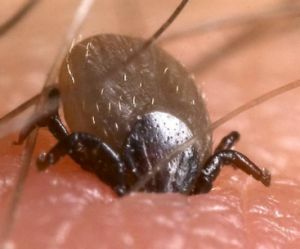 Infection occurs via tick bite, which occur in large numbers in mixed forests, and acquire activity in the spring-summer period.
Infection occurs via tick bite, which occur in large numbers in mixed forests, and acquire activity in the spring-summer period.
To date, Borrelia have been little studied. There are clinical results of studies that are questionable by one or another physician, but they all agree that spirochetes have a small diameter and are able to penetrate everywhere.
Propagate swiftly, at a temperature of about 35 degrees .It is allocated more than 10 groups of a various sort of borrelia on all globe, owing to it or this action of these or those antibiotics not always appears effective.
Signs and symptoms of Lyme disease
Symptoms of borreliosis after bite of mite:
- appears reddening of the skin as a stain( on the skin persists for several weeks, then passes by itself);
- stain is constantly increasing in size;
- has a round( less often oval and irregular) shape;
- the outer edge of the stain rises;
- possible headaches, general body fatigue, fever.
After 4 weeks, tick borreliosis has such symptoms:
- signs of damage to the nervous system, joints and heart;
- headache and sore throat, nausea;
- pain in the muscles and tendons;
- facial paralysis, insomnia;
- speech and memory disruption;
- arrhythmia, chest pain, dizziness.
 If you are interested in what signs of tick-borne encephalitis are different about Lyme disease, then you should read our material.
If you are interested in what signs of tick-borne encephalitis are different about Lyme disease, then you should read our material.
Tired an unbearable headache, and you can not choose a pill of migraine, reviews of doctors and patients will help to do this.
The first symptoms of borreliosis in humans after a bite of the tick
Lyme borreliosis has such initial symptoms:
- On the skin, at the site of a tick bite, in the first two days, redness appears. If dirt gets into it, a purulent focus can develop. Sometimes there is itching and tingling.
- Increased body temperature, dizziness, general fatigue.
Symptoms of acute
Like many diseases, Lyme disease differs in separate stages( І, ІІ, ІІІ) of .The patient does not always go through all stages, due to the fact that I and II are the early phases, and the third is the last.
First stage
Symptoms of tick borreliosis in the first stage of are characterized by the appearance of on the erythema skin, which has the form of a ring. Appears on the site of the tick bite and 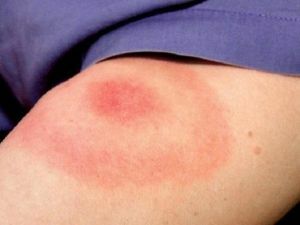 after diverging to other areas of the skin.
after diverging to other areas of the skin.
Patients are observed about bg fatigue, headache and pain in the neck, raising the body temperature to 40 degrees. Infection( at this stage already enters the blood) is accompanied by: chills, nausea, fever( within 2-7 days), constant drowsiness.
Sometimes there are no erythema on the skin, but there is a slight itch and tingling at the bite site.
Stage two - heavier
Symptoms of Lyme disease at the second stage:
- by the defeat of the nervous system and the development of Bannworth's syndrome or meningitis( headaches, facial paresis, nausea, vomiting);
- cardiovascular disease with the development of myocarditis, pericarditis and blockages of various degrees( pain in the heart, tachycardia, increased heart size);
- various skin lesions( redness);
- may develop conjunctivitis, arthralgia;
- there is an increase in the liver, manifested hepatitis( mild form), dropsy testicles.
This is due to the fact that Borrelia already penetrate into the organs and tissues of the patient's body. Most often, after a month, when the period of fever passes, the erythema disappears by themselves.
Stage three - final
Tick borreliosis( Lyme disease) has such symptoms on the third stage:
- arthritis;
- atrophic acrodermatitis( chronic form);
- encephalitis;
- polyneuropathy.
Chronic form
After a certain time, which can fluctuate in the 2-24 months limit, if there was a wrong diagnosis and treatment, the disease is transformed into a chronic form.
Characterized by:
- Defeat of large joints of , most often knee joints.
- The development of polyarthritis is possible, which is exacerbated over the next several years, and acquires a chronic form with relapses and
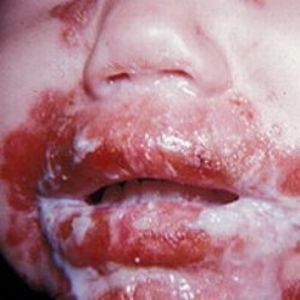 damage to bones and cartilage.
damage to bones and cartilage. - There have been cases when the chronic form has acquired the character of continuous relapses with the development of arthritis .Often, the patient's skin is affected. It appears as a lymphocyte( benign) on the earlobe, next to the nipple of the breast. On the skin they look like a dense bundle, bright red, not disappearing from the patient's skin for several months, sometimes even years.
- Diagnosed in chronic form and acrodermatitis flowing and developing for months and several years. It looks like bright red spots on the hands and feet, which have a tendency to periodically inflame, merge into a single whole and increase in size. The skin under them takes the form of "papyrus paper".
- The nervous system of the body is damaged.
- For several months or years the encephalomyelitis develops and acquires a chronic character, which manifests itself as multiple sclerosis with sleep disturbance, memory dips.
- Polyneuropathy , which is characterized by impaired sensitivity and radicular pain.
The most dangerous thing is that a chronic form can lead to a complete or partial loss of performance.
Diagnostics
When considering diagnostics, you should first of all pay attention to the time period of the year.
If this is the end of spring-early autumn( not excluding summer), should look closely at the skin of , after visiting forests, parks, gardens or lakes with abundant vegetation.
There is a danger( children are more likely to be exposed to it), do not pay attention to the bite, or do not remove the parasite from the skin in time, so there is a danger of infection.
If there was a tick bite, it's worthwhile to draw attention to:
- Erythema , most often they acquire a circular shape at the site of the tick bite. After diverge to other parts of the skin. Patients, in most cases, note the absence of itching.
- Do not neglect the laboratory tests of as the tick itself( if it was extracted from the skin), and the patient's analyzes( from the skin of the patient, his biological fluid) for the presence in the body and the amount of Borrelia. One of those is the analysis, confirming the presence of the disease, with the help of synovial fluid. The essence of the analysis is the detection of antibodies to borrelia in the serum. However, the analysis is considered ineffective in the first period of the disease.
In conclusion, I want to note that the mite bite itself is not dangerous, it is dangerous to keep infection in the parasite and the consequences of the development of the disease. Try to avoid visiting places during the activity of ticks, where an insect is possible.
If you still visited these places, take care.
Treatment of
disease Learn more details from our article.
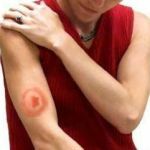 What should I do right after the tick bite and further treatment of tick borreliosis with antibiotics
What should I do right after the tick bite and further treatment of tick borreliosis with antibiotics Often enjoying the first spring sun and green foliage, or hiding from the summer heat in cool places under trees, on lakes in high grass. ..
Video: Tick-borne borreliosisLyme)
Tick borreliosis is an infectious disease, the source of infection most often is a tick. Characterized by the transmission of transmission. It affects the skin, nervous and cardiovascular systems, joints.

